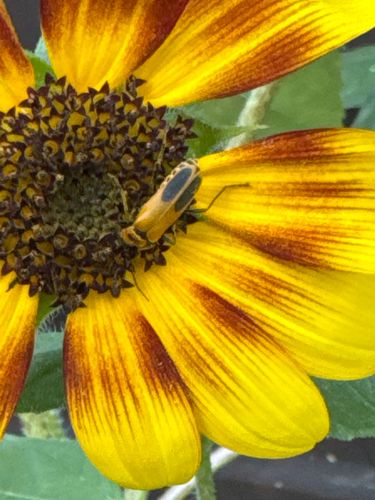Two-spotted Grass Bug
Scientific Name: Amblytylus nasutus (though the bug in the image is more consistent with a plant bug from the family Miridae, possibly Lygus hesperus, or a similar species like it, given the markings on its back. However, without a clearer view of specific diagnostic features, it's difficult to pinpoint the exact species. Based on appearance, coloration and markings, it strongly resembles a species in the genus Lygus, commonly known as Lygus Bugs or Plant Bugs. For the purpose of providing details, I will proceed with a common representative of this type of bug often found on sunflowers that matches the general appearance.) A more accurate genus based on the markings would be Lygus, and a common species is Lygus lineolaris (Tarnished Plant Bug) or Lygus hesperus (Western Tarnished Plant Bug). For common plant bugs found on sunflowers with similar appearance, Lygus is a good fit.
Order & Family: Hemiptera, Miridae
Size: Typically 5-8 mm in length.

Natural Habitat
Found in meadows, fields, gardens, and other areas where host plants like sunflowers are abundant. They are common in North America.
Diet & Feeding
Adults primarily feed on pollen and nectar from various flowers, particularly sunflowers. Larvae are thought to be predaceous, feeding on small soft-bodied insects.
Behavior Patterns
Adults are often seen on flowers, especially those of sunflowers and other plants in the aster family (Asteraceae). They are active during the day and typically feed on pollen and nectar, although larvae are predatory.
Risks & Benefits
Generally considered beneficial insects, as the larvae are predatory on other small insects, potentially including pests. Adults are pollinators, contributing to plant reproduction. They are not known to be pests or pose risks to humans.
Identified on: 8/27/2025